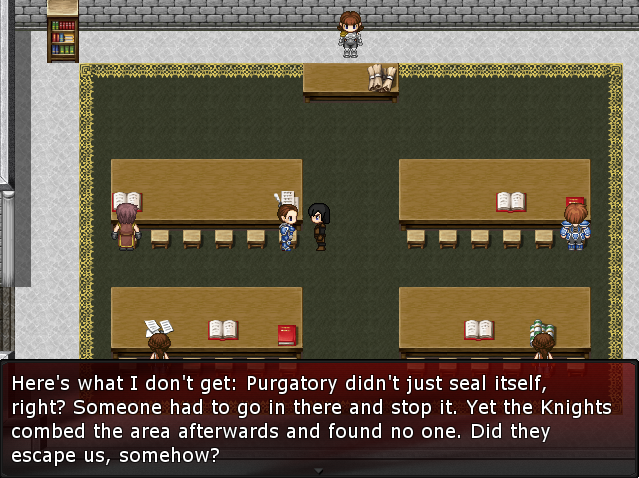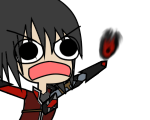 Add Review
Add Review Subscribe
Subscribe Nominate
Nominate Submit Media
Submit Media RSS
RSS
I say a little prayer for you
 CashmereCat
CashmereCat- 11/16/2015 09:10 PM
- 4165 views
PRAYER OF THE FAITHLESS
A review
for the demo released as @ Nov 2015
A review
for the demo released as @ Nov 2015
Note: May contain light spoilers, but nothing that I think will entirely spoil your experience, though.
Introduction
It feels good to return to the world of Soul Sunder. But things are quite different - this is a darker tinge of what we're used to. Whilst seeming a tad slow paced and plodding to begin with, due to the large amounts of exposition that needed to take place, it warms up in the second half with the brilliant characterization, and culminates on an exciting finale.
Story
What else should I expect from a Red Nova game but a solid storyline? The story did not disappoint. The characters are more engaging than ever. The game does take a while to start, but it kicks off after the initial exposition phase, and we start getting into the real feelings of the characters. This happens when we enter the forest.
Commandant Vanessa is blond with blue armour and she believes "it would be nice to believe in the potential of people again". She's like, the classic good guy that you're not supposed to like because they're cowardly. Then you've got redhead Paladin Amalie, my fave character in the game. She's so lovely... red hair, brown skin, elfish ears. She is a Manna, and she believes in the idea that "people can change".
Aeyr has grey hair, historically seen as the Problem Recruit. He's got a bunch of backstory I don't want to reveal to the general reader, but I think he's generally badass.

Here is evidence that he is awesome.
Mia is, as others have stated I'm pretty sure, in my opinion the weakest character. I don't see her motivation other than to be the love interest. To be honest, I would have much rather preferred Amalie as the love interest. Mia is just too cutesy and lovey dovey and like a little girl... I'm not into that anymore, I'm not 16 anymore. I like my women strong. Not that she's not physically strong, I just like headstrong women like Amalie. It might be a personal preference, but I feel she's got a deeper set of motivations, also.
As for the plot itself, it is a slow burn but it ends up incredibly engaging and finishes with a soaring cliffhanger. Aeyr starts off in a very scary dream, wakes up, and has to go to the Proving, where something rather sad and coincidental happens, causing a series of events which places him in an unfortunate position of being hated. Not that he ever wasn't in the first place.
Despite the exposition taking a while to actually get warmed up, all of it is very well implied rather than explicitly told. It's typical Red Nova "show don't tell" narrative brilliance. It ain't heavy-handed. It just takes a while to warm up, that's all.
Red Nova's trademark cynicism shines through again. There's a line where Paladin Amalie states to Aeyr that she protected him because she believes that the innocent should be protected without reason... something Aeyr couldn't believe. Red Nova simply can't give his characters entirely pure motivations. They have to come from a place of human vulnerability and need for personal gain. That's what makes them identifiable.
There is a fair share of humour, too, especially from the forest onwards. It's well done and lightens the mood a little bit, to make those player punches hit harder later on... and there are player punches. Ouch.
Slight spoilers ahead maybe, so close your eyes if you're squeamish... there is an extreme player punch near the end. I know an earlier reviewer complained that this story was too negative but... well... tragedies are negative and I can't say I can call that good criticism with a straight face. I have the same pet peeve against people who hate "unlikable" characters, just because they do immoral things or behave in a way that isn't morally upright. I'm like, get ova it, sons. To be "too negative" is a subtractive idea. There's far more depressing stories than this. If anything, the negativity is weighed evenly with the positivity to make a cool cocktail of interestingness...
DEFINITE SPOILER ALERT, SKIP THIS SENTENCE IF YOU WANT TO STAY UNSPOILED...
but I must say that the mysterious figure near the end intrigues me greatly. Know that the audience is probably hanging onto whether he's good or not. I think it was implied that he was evil, because of what happened to the main character near the end, but it was unclear... clarifying that later is going to be a real treat for the player to experience.
I liked that Aeyr didn't feel the need to confess anything to the priest, ever. :)
My favourite moment was the shock reveal at the end of the journey in the way back to the castle, at the exit of the forest. This mouth was agape.
All in all, the plot is really good and engaging and I love the characters. I'm not sure I felt the same about Soul Sunder so early in the game, so this might even surpass that in excellence. I hope so!

hehehe i'm pretty sure we know what happened here ;)
Gameplay
It is surprisingly solid, even more so than Soul Sunder's sophisticated battle system. Prayer of the Faithless' mechanics are even more well planned and thought out. It feels like a much leaner, stronger beast. The addition of the maximum 3 moves per turn limit forces the player to use strategy. Elemental weaknesses and strengths, character stances and the guard/SP balance are utilized phenomenally.
You're launched right into the fray, and in battle, you have a choice of Attack, Drive, Focus and Items. Focus regains SP. Jumping isn't communicated to you, but it's implied. Jumping is intuitive, if only feeling a little unnecessary and gimmicky. Another user mentioned a slight delay after each save, which I thought was a nitpick, but later on I found it noticeable and a little annoying.
It takes a little while for the game to warm up, both story-wise and gameplay-wise. There's a lot of exposition of story and gameplay mechanics which needs to happen within the first 30mins-1hr, but after that it picks up considerably. Once you hit the forest, there's fantastic gameplay choices from the get go. But up until then things are fairly linear and could get quite boring for the initial player. At least the story is interesting enough to hold your attention.

You have three actions per round. Have one character act thrice or spread out actions among the party.
The choice of which party member to attack with, and the obvious reactions to the decisions you make that relay to you what kind of effect your actions have on the enemy, allow for a massive amount of strategy. Like Soul Sunder, the heavy inclusion of SP into the battle equation that goes beyond a mere "currency for skills" is essential. It's even pushed as more important in this game than Soul Sunder, accounting for the armour of each person in this game, too.
It also pays to watch how much SP the enemy has, and the "scan" skill (which is not used, but is implicit whenever you target an enemy) will give you tons of information on how to target an enemy before you do it.
One issue I found was that it was almost too easy to escape. It felt like I could cheat my way out of any battle. I also wasn't sure whether the right strategy was to dodge battles like in Soul Sunder or to face them all head on... I figure you can grind later on? I'm not sure.
I love that there's lots of little items hidden in rocks and such, and that the pickup HUD is really unobtrusive. I liked using repeat Sheath/Unsheath from Mia's POV to slay large numbers of enemies, which actually got overpowered after a while, especially with very many enemies involved. There were instances where I was facing 4 bees, and all I'd have to use was Mara's Sheath/Unsheath to kill them all. I think this was on the way up the mountain.
Things like Miasma Charge and Amalie's cancelling "Piercing Light" skill add more strategy to battles. They all add layers. It's fantastic. What I love about this game is that strategy plays a huge part.
Graphics
Mapping was quite great. The portraits sometimes seem wonky but they're generally very distinct to the style. I liked that there were a lot of full portraits with many emotes. At first I thought the Hellspawn looked silly, but then later on it looked menacing... probably because the way that it was introduced made it more menacing, though.
My favourite map was the dream version of the castle, and how everything was beautifully fragmented. Loved finally visiting the actual castle and going "OH. SO THIS WAS THE PLACE WE DREAMED ABOUT". It was a cool moment.
Audio
I figured I'd lump in here that for someone who I recall once professing that he was tone deaf and didn't know how to pick songs. But the songs that were picked seem perfect, and they're epic and well-suited to each scene.

My favourite character. She's so great.
Presentation
A few presentation touches I wanted to mention. Statues give tips. This is kind of a trope in RPGs, but in Red Nova's games especially I've found that he makes people and signs in-game to tell the rules. It's a nice implicit way of setting the rules, and he usually disguises it so that it feels like these could be actual items that would be found in-game, instead of a sign just saying "PRESS X TO JUMP" or something. I find that clever.
The game generally makes unimportant elements uninteractable, such as average houses and other things that don't deserve to be explored. I liked this decision.
Just looting people's houses is lols because it's so easy... not even any examination animation or nothing. The unobtrusiveness of the item pickup HUD lends nicely to the flow of map movement.
Conclusion
Prayer of the Faithless is a fascinating and exciting new entry to the series. Gameplay is improved overall, the story is new yet exciting, and the characters are engaging. I thoroughly recommend Prayer of the Faithless even if you haven't played Soul Sunder, because it isn't required to have played that in order to enjoy this game. But knowing that they took place in the same universe lets you fill in certain gaps in the story. I loved the gameplay in this game. Very well-balanced. I have nothing massive to complain about in this game. It's an exciting new journey in a world I am a great fan of.
I am thoroughly anticipating this game's next demo release.

Posts 

Pages:
1
Red_Nova

Sir Redd of Novus: He who made Prayer of the Faithless that one time, and that was pretty dang rad! :D
9192
It's nice to see you put this as a review, Cash. This was too elaborate to be left as just a comment worth no MS. I'm so pumped at your enthusiasm for this game, and I'm gonna do the best I can to improve it in every way!
Sorry, I just wanted to bring it up again because it makes me laugh (in a good way) every time I see it. Cynicism = identifiable. You can't be kind and pure anymore. Nope.
Again, I'm so thrilled you loved it. And thanks to the PM you sent me with a bunch of issues to correct, there's that much more polish going into it. Thanks again!
Red Nova's trademark cynicism shines through again.
Sorry, I just wanted to bring it up again because it makes me laugh (in a good way) every time I see it. Cynicism = identifiable. You can't be kind and pure anymore. Nope.
Again, I'm so thrilled you loved it. And thanks to the PM you sent me with a bunch of issues to correct, there's that much more polish going into it. Thanks again!
This and Luxaren Allure released at practically the same time is awesome, and a great sign of Team Isolation's continued prowess. Now it's only a matter of finding the time to actually play them... Damn pharm academy! Though, I can write stuff in Latin now, so that's a plus.
And just to stay on topic, how much world-building is there relative to Soul Sunder? I haven't finished it yet, but I remember thinking world-building felt rather limited.
And just to stay on topic, how much world-building is there relative to Soul Sunder? I haven't finished it yet, but I remember thinking world-building felt rather limited.
author=NTC3
And just to stay on topic, how much world-building is there relative to Soul Sunder? I haven't finished it yet, but I remember thinking world-building felt rather limited.
Well, Soul Sunder was quite limited in location, that's probably the world-building was limited, and I honestly felt like the story benefitted from that. Soul Sunder primarily deals with the one outpost surrounding Purgatory, and the events that happen in that proximity. It was very internal in its dealings with characters, and I felt like the limited setting and focus on following the main character at all times instead of flitting between minor characters, allowed that to happen.
As for Prayer of the Faithless, we already see a difference from Soul Sunder in that it has a world map, so it's more focussed on what's happening in the world as a whole, and there are expository details that are dealing with kingdom's relations with towns, and what have you. But as for the storytelling itself, it still mostly deals with the psychology of the characters, which is actually what I find interesting in a story rather than extraneous details. In fact, I think Prayer of the Faithless benefits from its reluctance to include details that aren't important to the story. Of course, you might prefer for there to be reading materials like books on shelves, and so on, but in this game it seems as if something isn't needed, then it isn't included. Hope I answered your question correctly.
author=SatedWell, Soul Sunder was quite limited in location, that's probably the world-building was limitedIt's entirely possible to have lots of world-building even when only one town is represented. It's actually a very easy thing to do if you make sure that the people in a town give off the impression that they're there to do more than just serve the protagonists, that they'd have a purpose even if the protagonists weren't there. The one town in Soul Sunder is incredibly lacking in depth and is actually a pretty good example of how not to approach town-building in an RPG.
It depends on whether depth in worldbuilding is the goal. If you want your tale to have a somewhat fable-like quality about it and focus on the characters rather than the setting, it may be beneficial to keep details about the world to a minimum and focus on the local politics rather than the global ones. I think the idea of NPCs interacting with you like there is a world out there other than just to serve the player is a separate issue that is more concerned with creating realistic dialogue and motivations for NPCs than it is about worldbuilding. For example, in Prayer of the Faithless, the shopkeeper will tell you more about his relationship with his wife, his concern over a Paladin's social alienation due to her race, and his own nervous insecurities more than the state of the war and the outside world. Personally I think those details are a lot more important to the story.
Red_Nova

Sir Redd of Novus: He who made Prayer of the Faithless that one time, and that was pretty dang rad! :D
9192
author=NTC3
This and Luxaren Allure released at practically the same time is awesome, and a great sign of Team Isolation's continued prowess. Now it's only a matter of finding the time to actually play them... Damn pharm academy! Though, I can write stuff in Latin now, so that's a plus.
You learned to write in Latin? Me too!
... And then forgot it all while trying to find a use for it.
And just to stay on topic, how much world-building is there relative to Soul Sunder? I haven't finished it yet, but I remember thinking world-building felt rather limited.
As a hard side-by-side comparison, there's more focus on the world here than in Soul Sunder. I mean, there's still not a bunch of extra stuff added in for flavor (you won't see Bioware levels of codex entries!) but it still focuses on the people first and foremost.
author=Sated
It's entirely possible to have lots of world-building even when only one town is represented. It's actually a very easy thing to do if you make sure that the people in a town give off the impression that they're there to do more than just serve the protagonists, that they'd have a purpose even if the protagonists weren't there. The one town in Soul Sunder is incredibly lacking in depth and is actually a pretty good example of how not to approach town-building in an RPG.
Fair point. Though while I agree that there wasn't much depth to Haven's lore and it shouldn't be used as a model for other devs trying to build towns, I would argue that the amount of lore was just where it needed to be. There's a similar structure in Etrian Oddyssey Untold. There's only one town in the game, but the main focus (assuming you're playing story mode) is on the journey of the characters. While EOU makes references to other towns in it's story, the hub town in the game get very little development, serving as both a traditional town and place where the party interacts with each other.
Spoilers for the ending of Soul Sunder:
Remember how, during the credits, there was no one in town? I'm not trying to justify the lack of depth to a town, just to show that the lack of humanized NPCs was intentional. They literally had no purpose if the protagonists weren't there. You could learn all you needed to learn about the NPCs by tracking them down in the final Stratum and looking at their names.
Sorry for going off on that lengthy tangent. To go back on topic, I would make the same argument about PotF. As I said, the characters are once again the main focus of the plot. This time, however, there's a greater need to develop the world they live in, as it's important to the plot, and so the lore is going to get more focus.
Pages:
1














